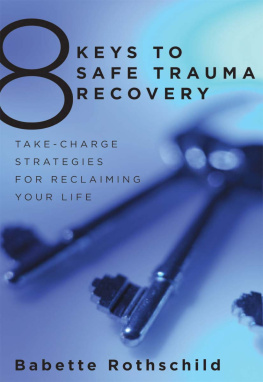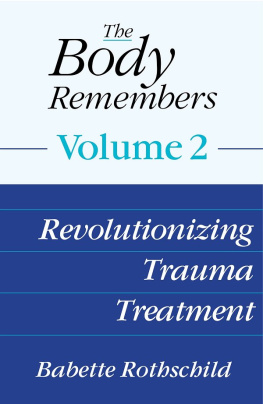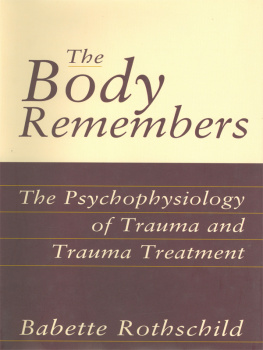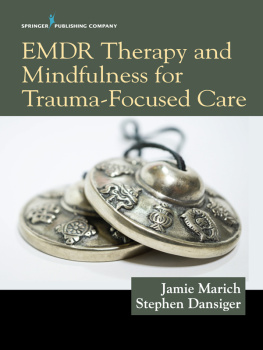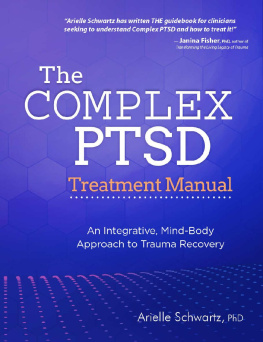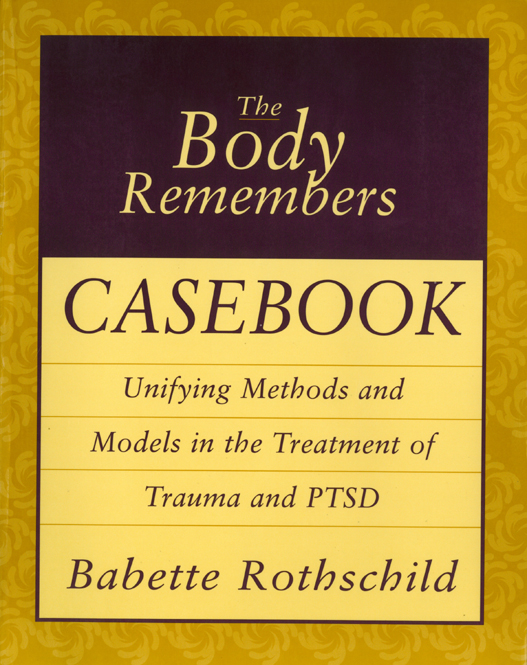
The
Body Remembers
CASEBOOK
Unifying Methods and Models
in the Treatment of Trauma
and PTSD
BABETTE ROTHSCHILD

W.W. NORTON & COMPANY
New YorkLondon
A NORTON PROFESSIONAL BOOK
In the broader definition of family...
To my siblings:
Melanie, with whom I share genes,
and Jeanne, Bob, Peter, and Susan with whom I dont.
You each have a special place in my heart.

T he main goal of this book is to inspire psychotherapists working with traumatized individuals to learn as much as possible about theory, tools, and treatment so that they can be well-equipped in working with the unpredictability of trauma and the diverse needs of clients.
The cases presented here are not meant to provide instruction on how to do trauma therapy in a particular, or even several particular, ways. The aim is, instead, to promote the practice of learning and then applying a variety of methods in combinations tailored to the specific needs of each client.
A further goal is for therapists to learn to trust and use their own common sense as a complement to, and sometimes in lieu of, what they have been taughtto become able to recognize when interventions are not helping a client even when they should, and when interventions that should not be helpful actually are.
ON COMMON SENSE
While I was living in Denmark, a window washer expressed interest in my work. When I told him what I did he asked, What tools do you use for that? It was an intriguing question. He wasnt asking me to give him a lecture on psychotherapeutic theory and method. His inquiry was much more basic and concrete; he was a workman and lived by his tools. I wanted to answer his question truthfully, but it was a challenge to do so. After thinking about it for a minute, I replied, I think my biggest tool is common senseand that is something they did not teach me at the university. He looked me straight in the eye and smiled, Yes, we all need plenty of that in our work.
Common sense is probably the first, most important ingredient of safe trauma therapyof making any psychotherapy safe, for that matter. However, it is astonishing to realize that common sense is rarely mentioned, let alone taught, in courses on theory or treatment. My London friend and colleague Michael Gavin can account for this omission, though: Common sense, he likes to say, isnt so terribly common.
There is a disturbing trend in psychotherapy, particularly in trauma therapy. Practitioners are becoming overly dependent on techniques that are learned and applied in a systematized manner, and are neglecting common sense and theory as aids to adapt these tools to the specific needs of individual clients. It is not that I find the protocols are lacking; actually, most of them are quite good. What is lacking too often, however, is thoughtful consideration before and during their application. When therapy methods are applied uniformly like a recipe, their potential for harm increases, no matter how good they are.
Merriam-Websters Collegiate Dictionary defines common sense as sound and prudent but often unsophisticated judgement. For the window washer this might mean discarding a recommended cleaning product that does not perform as promised, putting off washing outer windows when rain is threatening, or avoiding a shaky ladder. Examples of applying common sense to trauma therapy include: laying aside or changing a technique or protocol that makes a client worse, putting off the approach to potentially distressing material until the client feels safe, adjusting the length of therapy to the clients needs, or using basic theory to create appropriate interventions.
ELIMINATING CLIENT BLAME
In 1969 Joseph Wolpe, founder of behavior therapy, cautioned his students to look for the cause of treatment failures within the application of their therapeutic methods, not within their clients. He went on to warn that failures of behavior therapy should not be attributed to client resistance or investment in secondary gain. Wolpe believed that successful client change was the only justification for continuing with a particular method. In its absence, he advised, something different must be tried.
Our clients would greatly benefit from a broad application of Wolpes wisdom to all schools of psychotherapy, and particularly to todays methods of trauma therapy. We are at a particularly difficult juncture as trauma practitioners: Competition for the superiority of one method or model over another is fierce. This trend puts clients in a difficult position: Should they prioritize choosing a method or is it more important to find a practitioner who is a good fit? Too many trauma therapists offer only one technique, which leads to questions regarding client commitment when that method fails. In such circumstances, the client can be hurt.
Even the most effective medicine cannot cure all patients. Witness the miracle of penicillin, which was an incredible boon to public health in the wake of World War II. However, penicillin is not a miracle drug for the patient who is allergic to it; symptoms range from the uncomfortable to the fatal.
Of course, in terms of life or death, psychological treatment methods are less risky than penicillin. But some clients suffer unnecessary distress, become retraumatized, or even decompensate from the use of methods that are advantageous to others. Preferably, the choice of method is never perfunctory, but rather decided upon in consideration of and consultation with the client. And it is always a good idea to have other methods at hand in case the chosen method fails.
AN INSPIRING PROTOTYPE
In 1998 I witnessed a particularly poignant presentation at the annual meeting of the International Society of Traumatic Stress Studies. I had the privilege of being on the panel of the special symposium Issues in Creative and Body-Oriented Approaches to Trauma Treatment, chaired by David Read Johnson. The presentation of Betta de Boer-van der Kolk knocked my socks off. At that point in time, de Boer-van der Kolk, a clinical social worker who had not previously been exposed to body approaches, and her husband Bessel van der Kolk had been exploring applications of body psychotherapy to trauma treatment for several years. De Boer-van der Kolk had used herself, and her own trauma, to investigate the effectiveness of several methods. Those explorations became the theme of her paper Integrating Body-Oriented Techniques in a Conventional Psychodynamically Oriented Clinical Practice. In it she described her personal experiences in resolving a serious car accident that had occurred in her youth and continued to affect her life into her early fifties. What was remarkable about her experience, and the retelling of it, was how clearly she was able to describe the relevant contributions from diverse therapies. The two methods from which she sought help clearly met different needs. The first, Al Pessos psychomotor therapy, was instrumental in changing her feeling of isolation, helping her get back in touch with herself through repatterning the imprint of her familys response following the trauma. The second, Peter Levines somatic experiencing, helped her body to regain pretrauma homeostasis. It was clear from her presentation that either method alone, although helpful, would have left the resolution of that past event incomplete. The two therapies were consistent and compatible complements.
Next page

